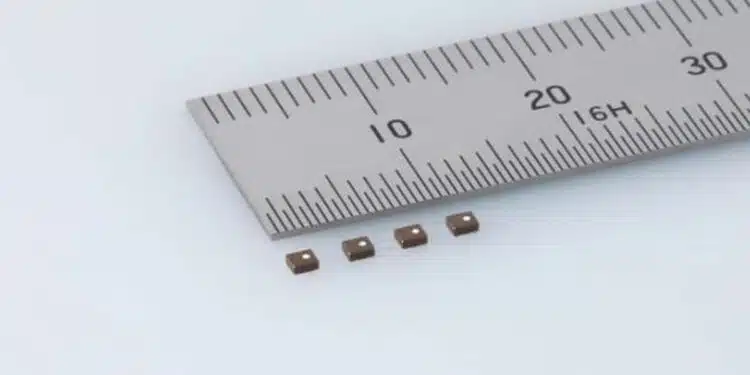TAIYO YUDEN expands lineup of Multilayer Chip Metal Power Inductors for smartphones featuring 20% improvement in DC superposition characteristics and 10% reduction in DC resistance compared to previous models.
TAIYO YUDEN CO., LTD. has begun mass production of three products, including the LSCND1412FETR47ME (1.4 x 1.2 x 0.65 mm; maximum height shown), in its MCOIL™ LSCN series of multilayer metal power inductors.
These power inductors are for use as choke coils in the power circuits of smartphones. Retaining the same form factor as our previous product “LSCND1412FETR47MC” (1.4 x 1.2 x 0.65 mm), the DC superposition allowable current of our new “LSCND1412FETR47ME” has been increased by 20% to 3.6 A
(previously 3.0 A), and its DC resistance has been reduced by 10% to 38 mΩ (previously 42 mΩ). These improvements contribute to boosting the performance of power supply circuits in smartphones, which are becoming increasingly sophisticated and multifunctional.
TAIYO YUDEN CO., LTD. has also begun mass production of two sizes and two products in the MCOIL™ LSCN series of multilayer metal power inductors, including the “LSCND1006HKT2R2MF” (1.0 x 0.6 x 0.8 mm; maximum height shown). These power inductors are for use as choke coils in the power supply circuits of wearable devices such as TWS devices and smart watches, which require ultra-compact size and high performance. The “LSCND1006HKT2R2MF” is approximately 50% smaller in volume than our previous product, the “LSCNB1608HKT2R2MD” (1.6 x 0.8 x 0.8 mm), and contributes to the miniaturization of these devices. Mass production of these products commenced in May 2024 at our subsidiary WAKAYAMA TAIYO YUDEN (Inami-cho, Hidaka-gun, Wakayama Prefecture, Japan). Samples are available for 50 yen per unit.
Technology Background
Smartphones
Smartphones are becoming increasingly sophisticated, with capabilities such as AI-based image and video editing, as well as voice and text translation. At the same time, there is demand for greater efficiency in order to keep their body small, and achieve long operating times with limited battery capacity. To achieve both high performance and high efficiency, a smartphone’s processor operates at high speeds with low voltage and high current, and employs a multi-core configuration where each core is equipped with its own power supply circuit, allowing it to improve both its processing power and efficiency by switching the cores used depending on load. This trend in power supply circuits has become particularly pronounced in cutting-edge smartphones, which require both high performance and high efficiency, and in recent years has led to an increase in the adoption of small and thin low-inductance power inductors capable of handling large currents.
To address these needs, at TAIYO YUDEN we have been using metallic magnetic materials with high DC superposition characteristics to optimize the design and other aspects of our MCOIL™ LSCN series multilayer metal power inductors—which have the advantage of allowing them to be made more compact and
thinner—commercializing three products, including “LSCND1412FETR47ME,” which deliver 20% greater DC superposition allowable current and 10% smaller DC resistance compared to our previous products. In response to market needs, we will continue to expand and improve our product lineup with higher
functionality and reliability, as well as smaller and thinner products.
Application
For use as a choke coil for power circuits in smartphones and other devices.
Wearable devices
Wearable devices need to be compact, deliver high performance, and operate for long periods of time. In particular, TWS devices require enhanced functionality, such as noise canceling, support for high-resolution audio, and advanced sensors for detecting when the earphone is worn or taken off, as well as acquiring location information. For this reason, power supply circuits must be both compact and highly efficient, and these circuits require compact and high-inductance power inductors that are capable of handling large currents, while also having low DC resistance.
To address these needs, at TAIYO YUDEN we have been using metallic magnetic materials with high DC superposition characteristics to expand our lineup of MCOIL™ LSCN series of multilayer metal power inductors which have the advantage of allowing them to be made more compact and thinner. With our latest
upgrade, we have commercialized the “LSCND1006HKT2R2MF,” which has a volume approximately 50% smaller than our previous product, the “LSCNB1608HKT2R2MD” (1.6 x 0.8 x 0.8 mm), while maintaining a DC superposition allowable current of 0.8 A and achieving a low DC resistance of 375 mΩ.
In response to market needs, we will continue to expand and improve our product lineup with higher functionality and reliability, as well as smaller and thinner products.
Application
For use as a choke coil for power circuits in wearable devices such as TWS devices and smart watches.































